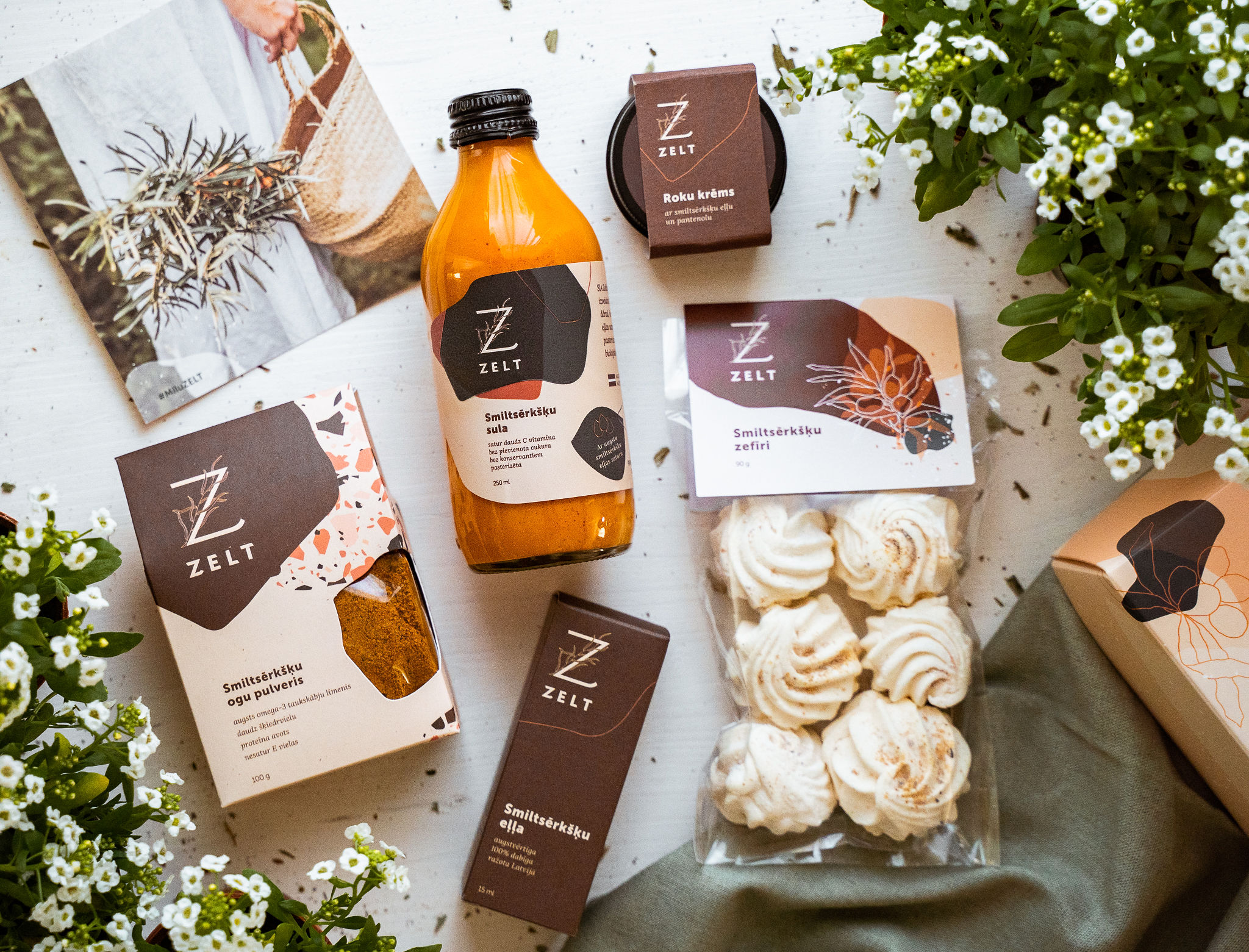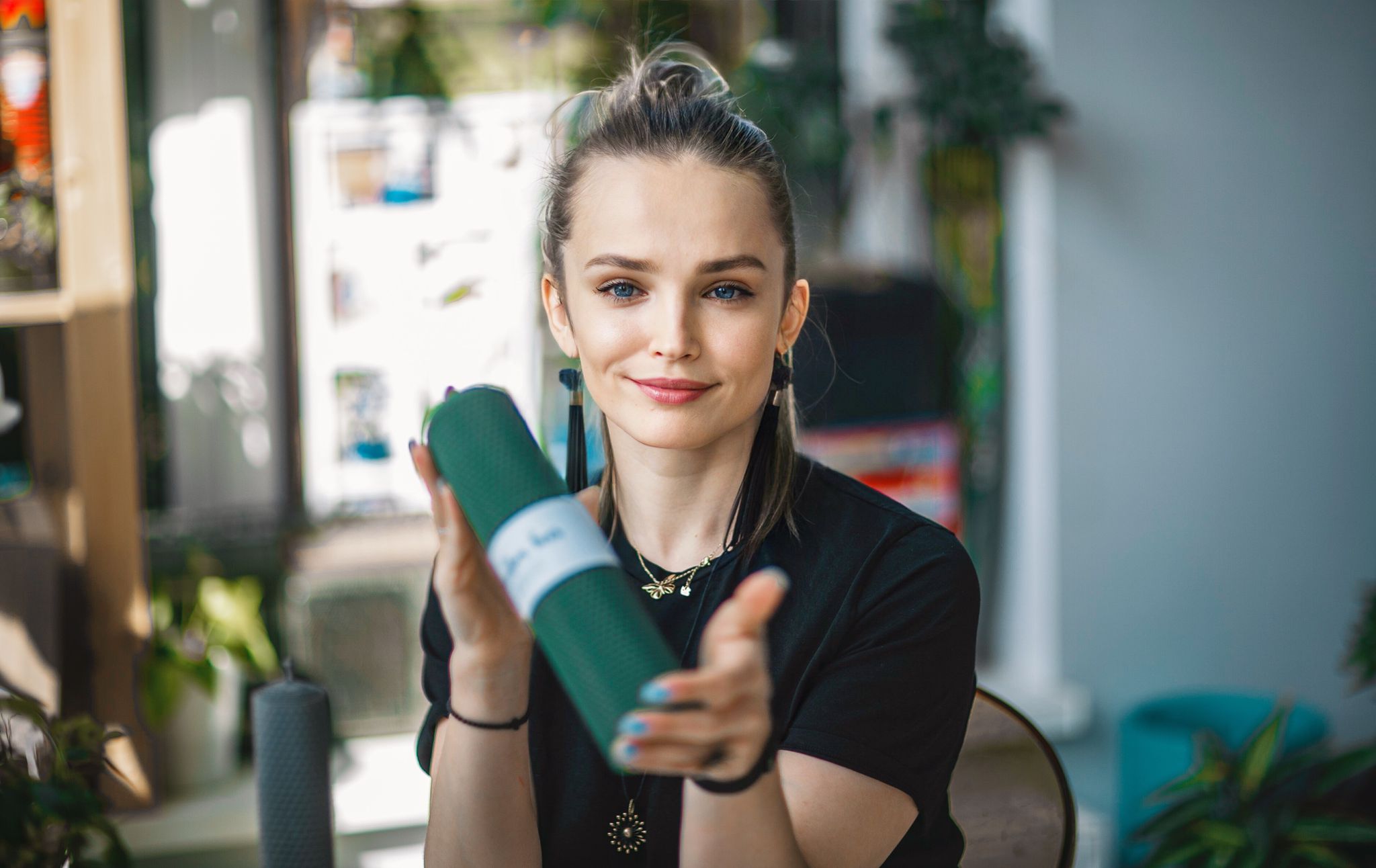Sign up for newsletters
Stay up to date on the weekly newsletters on recent news and activities.
05.04.2022 - Companies, Food processing & retail, Innovation
Investing in design has helped three family-owned businesses in Latvia find a niche in the market for their locally-sourced natural products.
ZELT grows sea buckthorn, makes its own range of edible berry-powered goods and cosmetics and runs an open garden and workshops near Jelgava. Plūkt hand-picks wild herbs from certified meadows and forests and processes them for tea in the fields of Prauliena, and Theodor’s Bees produce hand-rolled candles. In a market saturated in traditional and soy wax candles, they introduced colorful beeswax candles with a longer burn time.
Product and brand design were fundamental considerations for all three. ZELT owners Elīna Cēsniece and Eduards Vilks emphasize that they didn’t grow from selling juice in plastic bottles into what they are now: “We wanted to start with a bang, on social media too, so we didn’t launch until we had quality images, a logo, and graphic design.” They held internal workshops before turning to a design professional to transform their ideas into a functional results.

Publicity Photo
For Māra Lieplapa, founder of Plūkt, visiting a tea forum and training in China made her only more confident to invest in design after seeing how traditional the tea industry is. She turned to a design agency before the product was even finalized.
While Theodor’s Bees founders Kristīna Ozola-Ozoliņa and her husband have not worked with external designers, they continue to invest their own time and knowledge into the brand identity, product, and packaging. A brand from Ukraine inspired them to experiment with beeswax and dye.
When asked how each would define good design, the answers are similar. For Māra “good design leaves no room for questions about the product. It should make you feel something. Even better if that feeling corresponds with your values.” Elīna and Eduards describe it as “visual, functional and sustainable. Everything goes hand in hand.” And Kristīna outlines good design as “understandable from the moment you cast your eyes on it.”
The design has helped each of them achieve their business objectives, and brought unexpected benefits.
Design Is a Medium; it Conveys Your Story
Māra shares how the design was the only tool they had to tell the Plūkt story while developing the product: “It worked very well because that’s the first thing people notice. The brand name and identity.”
Starting from that first moment, design shortens the communication time between the client and the product, Māra explains: “At a shop, for example, when a client sees a product, the design does the talking.” Since Plūkt’s guiding idea is to cultivate a Northern European tea-drinking culture Māra thought: “If our goal is to spark something new like that, and export, then we need to be the pioneers who lead the way with the help of design.”
For ZELT the mission is to educate people on the health benefits of sea buckthorn. Elīna and Eduards made sure the design would convey their message “so people would learn about and start to use the berry, become healthier and happier.”
Design Contributes to Turning a Product into an Experience
By involving design, a product can gain new dimensions, lead to a stronger reaction, and a more thorough and engaging experience.
Eduards has observed that “people need to not only physically receive a product, but also enjoy it from an aesthetic point of view. The complete experience consists of a physical or technical part and a visual, aesthetic one. That’s to say, a product needs to look appealing and also be a pleasure to use or consume.”
Encouraged by customer feedback, Elīna and Eduards entered their ZELT packaging into several design competitions in Latvia. By doing this they discovered vectors they never would have thought of. “We did well, our beer labels won first prize and that led to publicity. The printing house included a few of our designs in their email signature. That’s extra advertising for us.”
Since Theodor’s Bees recognized that people expect a candle to not just function, but also look good in an interior, Kristīna has experienced clients buying them for decorative purposes. She remembers one particular case: “Last year, a lady with a phobia of candles bought some to display in her home.”

Publicity photo
Updates Are Called for but Basic Values Are Constant
As businesses expand, so too do their design needs, but good design is built on solid foundations and takes time to finalize.
Elīna explains that ZELT has a brand book but even so most of the final packaging is the fifth or sixth attempt. “Of course, tweaks happen too. We started with two products, and now have fifteen and additional product categories. We’re always thinking how one thing goes along with the other because they have to differ but match.”
Māra echoes the experience: “You start with the basic design, which represents your brand values. Of course, we’ve made adjustments and we do introduce new products, which don’t always look the same.”
Adapting to New Situations is Part of the Story
Needs also change when a business launches export operations. Theodor’s Bees are now ready to start, however, Kristīna and the team realized that the boxes are not suitable, and the labels and logo will have to be adapted. They also learned that people want to open the box hundreds of times and it loses its original appeal, so they are reworking the packaging.
For Elīna and Eduards the war on Ukraine caused an unprecedented development: “Never in a million years could we have predicted that the letter Z would become a pain point. We’re now removing single letters from our packaging and sticking with the full brand name ZELT. We haven’t received any criticism but it feels right to make the change.”
Design Goes Hand in Hand with Every Other Aspect of the Business
Plūkt, ZELT, and Theodor’s Bees make it clear that design is just one component of their success. Kristīna is open about the reality of running your own business, managing product development, sales, marketing, and quality control. “We didn’t really sleep for all of last year,” she says.
Eduards and Elīna stress the importance of the entire brand experience. In their case “it starts with the attention we pay each sea buckthorn bush and ends with how our clients receive our product. In between is how we treat our clients at our garden, through our customer service or website. All parts are equally important. When a person buys a product, we need to make sure they will buy it again because they are sure of the quality.”
To Invest in Design or Not?
For anyone fearful or doubtful of the potential return on investment, ZELT, Plūkt, and Theodor’s Bees have some words of encouragement.
Māra recommends putting your trust in professionals: “Ask yourself if you have the skills to design in the long term. Look at brands you admire. Would they have achieved what they have if they went it alone?” On finding the right designer she says: “It’s like sales. Trying to sell your vision to someone, so that they believe in it and jump on board.”
Kristīna suggests starting small: “Plenty of companies like printing houses are forthcoming and happy to take on small projects. Also, don’t think about profit as soon as you get going.”
Elīna and Eduards recommend identifying which parts of the business process you resonate with and want to be personally involved in. “Design is not something you can force. You have to love it and have an established inner aesthetic,” they say, and urge choosing a designer to who you feel a connection.
Source: labsoflatvia.com
Stay up to date on the weekly newsletters on recent news and activities.
Stay up to date on the weekly newsletters on recent news and activities.